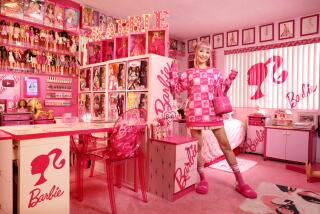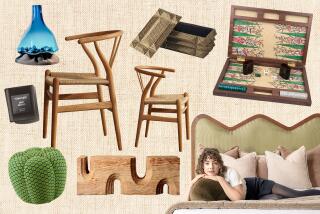Retailing and Ridicule: Old Partners
- Share via
Political correctness is a recent concept, as a look at the toys of yesteryear demonstrates.
Caricatures in pictures and on small ceramic souvenirs and children’s toys often poked fun of people.
The Teddy and the Bear bank shows President Theodore Roosevelt holding a gun and looking at a cub he declined to shoot--a decision that would delight today’s animal activists.
*
Question: My grandmother has offered me her white chenille bedspread. When was chenille popular?
*
Answer: Chenille is a cotton fabric with a surface of raised, tufted patterns.
“Chenille” is the French word for “caterpillar.”
The fuzzy fabric was first made as a home craft in Georgia about 100 years ago. Women stitched loops of thread through the back of a muslin sheet. After the fabric was washed, the loops were cut to create the tuft.
By the 1930s and ‘40s, chenille was at its peak of popularity. By that time, it was made by machine and was used to make bedspreads, rugs and bathrobes.
The best chenille spreads were white with colored tufts.
Be sure to thank your grandmother for her gift. Chenille is popular again.
*
Q A set of dishes I inherited are marked “Limoges China Co. U.S.A.” I thought Limoges was made in France. My dishes have gold trim and an “H” monogram.
*
A Limoges is a city in France where porcelain has been made since the late 1700s. Hoping to make china of the same quality, the Sebring family founded a pottery in eastern Ohio in 1899 and marked its china “Limoges.”
In 1904, the Ohio pottery was renamed the “Limoges China Co.” After Haviland & Co. and the city of Limoges, France, filed a lawsuit in the 1930s, the Ohio company changed its name to American Limoges China Inc. It closed in 1958.
The pottery’s dinnerware was made of soft paste that was creamy white and heavy. French Limoges dinnerware is purer white, translucent and lightweight.
The mark on your plate was used by the Ohio firm from 1910 to 1930. Collectors refer to your dishes’ pattern as “Socialite.” It also had various monograms.
*
Q My parents left me a set of 1950s cherry bedroom furniture. Unfortunately, it was stored too long in a closed room, and the drawers smell moldy. I have tried commercial disinfectants, but nothing has worked. Can you help?
*
A Spread some fresh coffee grounds in the drawers and let them sit for at least 24 hours. They might absorb the odor.
If that doesn’t work, sprinkle the drawers with baking soda, and leave them open for a week. Vacuum and repeat if necessary.
If the smell persists, parch several handfuls of uncooked rice in a shallow pan in the oven. Place the pan and rice in a musty drawer to absorb the odor.
You also can try spreading cat litter or charcoal chips in the drawers. Close the drawers for several days, and repeat until the odor disappears. Then wash the inside of the drawers and let them dry.
Some people solve the problem by placing the drawers outdoors in the shade, then using a fan to blow air through the drawers.
If none of these methods work, varnish the inside of the drawers to seal in the odor.
*
Q Can you tell me anything about the mantel clock I found on a farm in Wisconsin? The wood has an inlaid design, and the clock face is marked “Sessions.”
*
A The Sessions Clock Co. of Forestville, Conn., dates to 1903, when William Sessions and his son bought out the E.N. Welch Manufacturing Co.
Your tambour (round-top) shelf clock is one of many similar clocks Sessions made during the 1930s. Your clock was made in a pattern Sessions called “Shelley.” The company used the same inlay pattern on the front of other tambour clocks with other pattern names.
For a listing of helpful books and publications, include a self-addressed, stamped (55 cents) envelope to Kovels, Los Angeles Times, King Features Syndicate, 235 E. 45th St., New York, NY 10017.
Current Prices
Current prices are recorded from antiques shows, flea markets, sales and auctions throughout the United States. Prices vary by location because of local economic conditions.
* Hand-painted necktie, black with white cat, rhinestone eyes, 1940s: $60.
* Political button, “In Your Heart, You Know He’s Right!” Barry Goldwater, 1964, 3 1/2 inches: $25.
* Quick Curl Barbie, original box, Mattel, 1972: $45.
* Toy sewing machine, Casige, “Made in Germany--British Zone,” Gesch M1470 stamped on sewing plate, metallic green: $135.
* 1948 Cleveland Indians World Series pennant: $150.
* Waldock 50-pound lard tin, geese flying over water, Heekin Can Co., 12 by 15 inches: $175.
* Old Ivory No. 75 cake plate/tray, open-handled, 12 inches: $195.
* Silver bowl, shaped body, applied acanthus leaf and scroll rim, shell-and-scroll feet, Gorham Manufacturing Co., circa 1875, 8 3/8 by 12 1/2 inches: $310.
* Medical cabinet, Physicians Specialty Co., Leesburg, Va., Thompson plaster, solid oak, five beveled glass panes set in oak showing instruments for ear-nose-and-throat doctor, circa 1909, 17 1/2 by 22 1/2 by 40 inches: $3,500.
* Lalique lamp, table model, Suzanne, frosted amber, nude dancer, outstretched arms holding lengths of drapery, bronze base, marked, circa 1925, 9 inches: $6,620.
More to Read
Inside the business of entertainment
The Wide Shot brings you news, analysis and insights on everything from streaming wars to production — and what it all means for the future.
You may occasionally receive promotional content from the Los Angeles Times.










